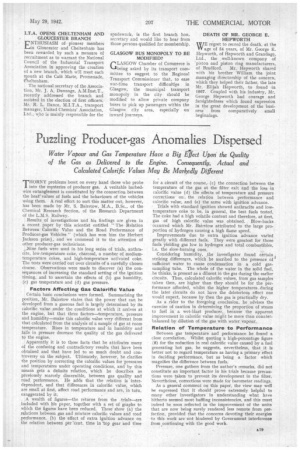Puzzling Producer-gas Anomalies Dispersed
Page 21

If you've noticed an error in this article please click here to report it so we can fix it.
Water Vapour and Gas Temperature Have a Big Effect Upon the Quality of the Gas as Delivered to the Engine. Consequently, Actual and Calculated Calorific Values May Be Markedly Different
THORNY problems beset on every hand those who probe into the mysteries of producer gas. A veritable barbedwire entanglement is constituted by the connection between the heat values of fuels and the behaviours of the vehicles using them. A real effort to sort this matter out, however, has been made by Mr. S. Bairstow, M.A., B.Sc., of the Chemical Research Section, of the Research Department
of the Railway.
Results, of investigations and his findings are given in a recent paper by this scientist entitled " The Relation Between Calorific Value and the Road Performance of Producer-gas Vehicles" (which has won him the Herbert Jackson prize), and we commend it to the attention of other producer-gas technicians.
__Nine fuels were used in his long series of trials, anthracite, low-temperature coke, charcoal, a number of mediumtemperature cokes, and high-temperature activated coke. The tests were carried out over circuits of a carefully chosen course. Observations were made to discover (a) the consequences of increasing the standard setting of the ignition timing, and to ascertain the effects of (b) gas humidity, (c) gas temperature and (d) gas pressure.
Factors Affecting Gas Calorific Value Certain basic conclusions were formed. Summarizing the position, Mr. Bairstow states that the power that can be developed from a gaseous fuel is largely determined by its calorific value under the conditions at which it arrives at the engine, but that three factors—temperature, pressure and humidity—make this calorific value very different from that calculated from the analysis of a sample of gas at room temperature. Rises in temperature and in humidity and falls in pressure decrease the quality of the gas delivered to the engine.
Apparently it is to these facts that he attributes many of the confusing and contradictory results that have been obtained and that have led to so much doubt and controversy on the subject. Ultimately, however, he clarifies the position by correcting the calorific values for pressures and temperatures under operating conditions, and by this mean's gets a definite relation, which he describes 'as previously scarcely discernible, between gas quality and road performance. He adds that the relation is interdependent, and that differences in calorific value, which are small at first, affect road performance and are, in turn, exaggerated by it.
. A wealth of figures—the returns from the .trials—are included with his paper, together with a set of graphs to which the figures have been reduced. These show (a) the re-lations between gas and mixture calorific values and road performance, (b) the effect of extra ignition advance on the relation betweenper 'cent, time in 'top gear and time for a circuit of the course,(c) the connection between the temperature of the gas at the filter exit and the loss in calorific value (d) the effects of temperature and pressure correctioeis' on the relation between performance and calorific value, and (e) the same with ignition advance. Trials with standard ignition showed anthracite and lowtemperature coke to be, in general, the best fuels tested. The coke had a high volatile content and therefore, at first, gas of high calorific value was obtained. Blow-backs occurred which Mr. Bairstow attributed to the large proportion of hydrogen causing a high flame speed.
Improvements due to extra ignition advance varied greatly with different fuels. They were greatest for those fuels yielding gas low in hydrogen and total combustibles, i.e. the slow-burning ones.
Considering humidity, the investigator found certain striking differences, which he ascribed to the presence of ' sufficient water to cause condensation in a cold gassampling tube. The whole of the water in the solid fuel, .he thinks, is present as a diluent in the gas during the earlier circuits. Thus, calculated calorific values, from gas samples taken then, are higher than they should be for the performance afforded, whilst the higher temperatures during the later circuits do not have the deleterious effect one would expect, because by then the gas is practically dry.
'As a rider to the foregoing conclusion, he advises the exercise of caution in determining the proportion of steam to fuel in a wet-blast producer, because the apparent improvement in calorific value might be more than counterbalanced by dilution of the gas with water vapour.
Relation of Temperature to Performance Between gas temperature and performance he found a close correlation. Whilst quoting a high-percentage figure (8) for the reduction in real calorific value caused by a fuel generating hot gas, he suggests, nevertheless, that it is better not to regard temperature as having a primary effect in deciding performance, but as being a factor which magnifies the difference between fuels.
Pressure, one gathers from the author's remarks, did not constitute an important factor in his trials because precautions were taken to prevent its development in the filter. Nevertheless, corrections were made for barometer readings, As a general comment on this paper, the view may well be expressed that it should prove extremely helpful to many other investigators in understanding what have hitherto seemed most baffling inconsistencies, and this must indeed be soon reflected in the improvement of the units that are now being surely rendered less remote from perfection, provided that the concerns devoting their energies to this work are not hindered by Government interference from ,continuing with the good work.




















































